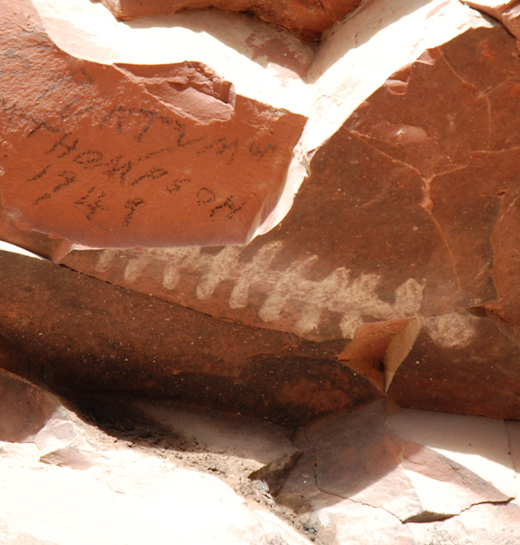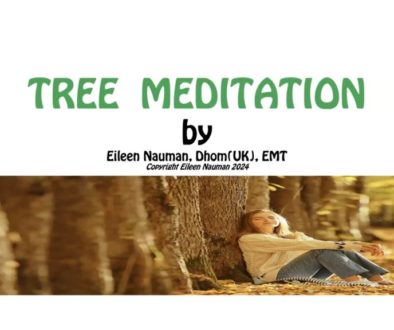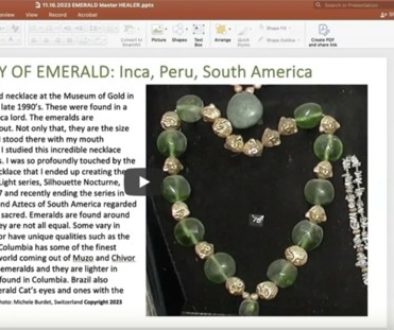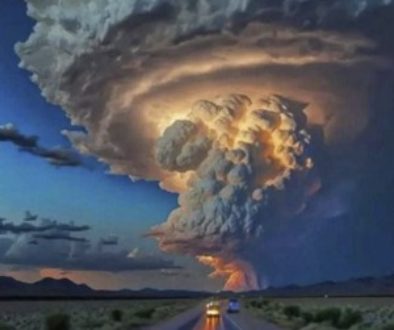Walking the Land: Honanki Ruins and Petroglyphs, Sedona, Arizona, Part I
We went out to these ruins, near the Loy Butte area. It was an easy walk to the ruins that were built along the southern side of a huge red and white sandstone and dolomite butte. According to information Honanki is Hopi for “Bear House.”
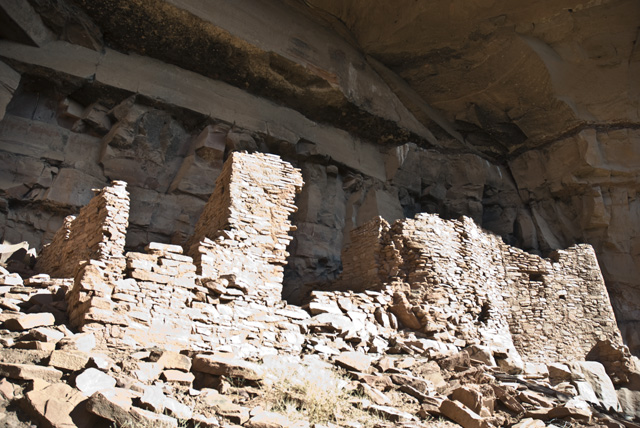
This is the first view you get of the Honanki ruins. It’s huge and amazing.
As we walked toward it on the path, on the right I noticed a boulder and on it was a SPIRAL carved into it. I noted this to Marty because sometimes, there are ‘signs’ that tells us something about the site we are approaching.

Further on, we met this incredible (probably a thousand-year-old) Alligator Juniper tree. She is a tree guardian into this site. You can see how massive it is with Marty standing and touching it. We ask this tree spirit for permission to move on to the ruins. She gave it to us and we thanked her.
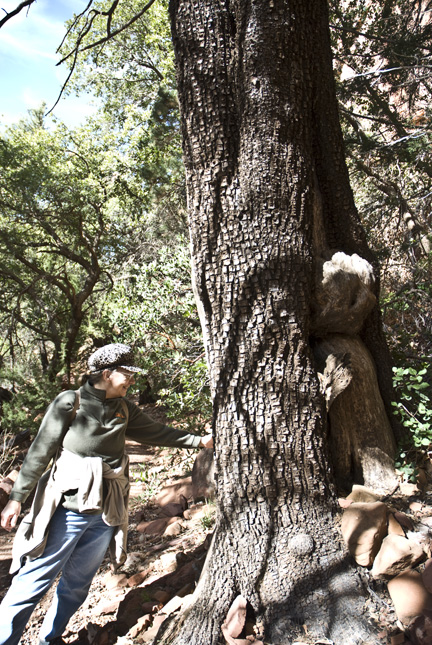
Here is that huge, old Grandmother Juniper. She is a gate guardian and we stopped, gave our names and why we were here at these ruins. We asked her permission if we could move on toward the ruins.
Marty gave her some cornmeal; a gift that is always welcomed by our partners in Nature. Grandmother gave us a ‘go’ and we continued on toward the ruins. The path stops and you can go left or right. Straight ahead are the magnificent ruins staring at us. Like most ruins they are built back into hollowed out areas of the rock so that when it rains, the flagstone and mud built homes are kept dry. And, they face south to take advantage of the winter southern sun that will warm them. And the first petroglyphs were here–and they were stunningly huge and beautiful.
The one that caught our attention was a human being standing below a white circle. It appeared that she or he were celebrating it. Was it the sun or the moon? I don’t know. And then, below that were a whole group of petroglyph animals that were sharp, clear and beautiful. You could see a desert mountain sheep and probably deer or elk.
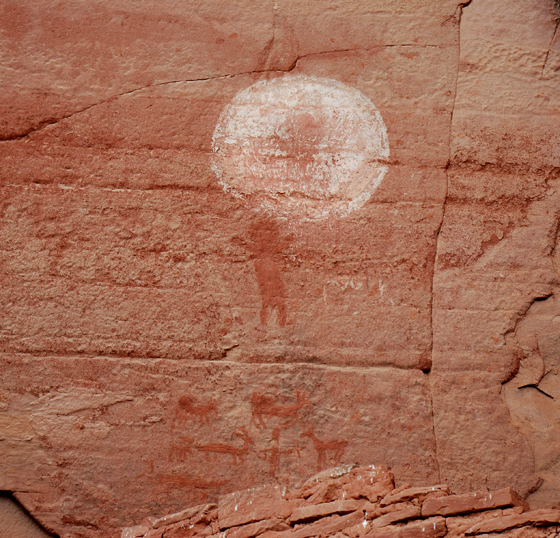
This just blew me away as we came around the path and here in front of us is this amazing, huge (must be at least 9-12 feet tall) petroglyph of a person with his or her arms upraised toward the sun or moon. Then, down below this one is wonderful petroglyphs of animals and a hunter.
Marty asked which way I wanted to go. I was being pulled to the left path, the western end of Honanki. She agreed and we followed it until we had to stop. I saw my first petroglyph high on the red sandstone face and it was a circle with three vertical, wavy lines. I wondered aloud if it signified rain or lightning bolts, or both. A circle is about completion of a cycle. Was this a rain cycle? I didn’t know. There were also some animal petroglyphs. I drew them in my sketch notebook I always carry with me. They appeared, at least to me, to be wolves or perhaps coyotes in a pack.
Marty and I both agreed that Honanki is a lot more ancient than what present-day archeologist give it. They say the Sinagua Indians were here at this site from 1100 to 1400 AD. While I don’t question them, we both felt an older, far more ancient energy that was present here that probably couldn’t be measured in left brain means.
We both agreed to settle in, move into an altered state and see what we could find or discover that wasn’t right in front of our eyes. As I sat on a rock and closed my eyes, I moved into my altered state of non-ordinary reality. Immediately, I saw a golden figure standing nearby. I gave my name and asked politely if this being could give me more information about Honanki.
The oblong golden energy assumed a familiar shape: This was one of the seven grandmothers that I had come into contact with in 1990 over at the Boynton canyon cliff dwellings. There is one cave over there that hold the ruins. There is a second cave to the south of it where it is protected by cactus so that few really want to get over to it. I had been drawn to that cave right off the bat and had gingerly threaded the cactus, after asking permission to go to that cave, and climbed up in it. There, seven women, tall and short, young and old, greeted me. I called them the Seven Grandmothers. They told me that they were guardians of this area. I didn’t realize the scope of the ‘area’ that they were associated with.
When the one Grandmother showed up to me at Honanki, I was surprised and pleased to see her. There’s a lot of love that emanates from these guardians and I felt showered by her maternal love. As always, if you don’t ask, you don’t get. I knew from decades of experiences with guardians of such sites, that if you didn’t ask questions, they remained mute. They aren’t here to teach us. If we don’t have the curiosity to ask, they just stand there looking at you.
I asked the Grandmother what was the purpose of Honanki. She said first, it was a thriving, busy village. And that all the ceremonies for this area (she included Palatiki, another Sinagua ruins to the east of us and the Boynton Canyon cliff dwellings, in her statement) for boys and girls coming of age from child to adult were performed here at Honanki.
I asked if there were any other ceremonies. She said that the three villages conducted ceremony when the Pleiades rose in the east. This signaled winter and the beginning of Spring to them. They also did a ceremony when the Pleiades set on the western horizon, around March (which would be Spring vernal equinox).
My ears perked up on the Pleiades being mentioned. I asked her if the other six grandmothers were also a part of this larger picture. I told her I thought the seven of them lived and stayed in that cave in Boynton canyon. She gave me a patient smile like a mother would her inquiring child. She said that the Seven Grandmothers were symbols of the seven stars in the Pleiades. That each of them were an archetypal energy for that given star in this constellation that shined down upon the Earth.
I then realized with a jolt that yes, the Seven Grandmothers had told me back in 1990 they told me then the same thing. And I had completely forgotten about it! Of course, 1990 was a long time ago so I let myself off the hook. I told her, that now she had jogged my memory, that yes, I did remember them saying they were from the Pleiades.
She then said that the original ancients who came here (we’re taking 10-20 thousand years ago) had originally settled this area and had come from the seven stars of the Pleiades–which is why they Sinagua carried that blood in them and why they did yearly ceremony involving their home constellation.
I asked her if they did any other major ceremonies at Honanki and she said yes, that at the beginning of Spring, they three villages got together with all the other dwellings in the Verde Valley. They all made the trek, mother, father and children, to Montezuma’s well. This is a beautiful dolomite (white) stone well and the water is crystal clear and a beautiful Caribbean blue color. (There are also dwellings there as well).
I asked her to describe the ceremony.
She said that in the Spring all those who lived in this valley trekked to the well. There, the elders conducted a ceremony to call the “Colored Snake” up and out of the well. Instantly, I remember Bololokan of the Yavapai Indian myths–the ‘rainbow’ snake that we had dealt with last year. I visualized Bololokan to her and ask if this was the same snake guardian and she said yes it was. But it was called a colored snake by the Sinagua in their language description of this energy archetype.
I asked her what the ceremony was about. She said that every Spring the people gathered. And the elders would call the colored snake up and out of the well. When the snake came and appeared, the people would sing, dance and pray that it would bring enough rain so that their crops would thrive and they would not starve in the coming year.
I was very excited about this aspect. It was wonderful to see the same snake working with those humans who inhabited the area. And often, in Indian symbology, the snake did symbolize the rain. It was a rainmaker.
I asked the Grandmother if there was a summer ceremony, since there were others in place for the other times of the year. She said yes, that there was a summer ceremony between the three dwelling sites. She showed me the constellation of Cassiopeia. It is a “W” in the sky. And as I ranged quickly into my left brain, I did remember that Cassiopeia did, indeed, come across our summer sky. I wondered about that connection to that constellation, but didn’t investigate any further than that because I was excited by the picture she was building of the area.
I asked her about the three dwellings being connected to one another. She said that the whole Verde Valley was at peace and that the various cultures established here thousands upon thousands of years ago, traded and worked with one another. She then drew a yellow energy trail to connect these three together and it was a TRIANGLE.
Well, from our discoveries and exploration of Sedona’s seven chakras last year, we knew that triangles were very important to this region. I asked her if there were any more triangles in this area.
The Grandmother said that the volcano (now known as House Mountain in modern day terminology and where I presently live beneath its shadow) and the vent (Marty calls this volcanic vent El Shadai) and Humphrey’s Peak to the north (this is Flagstaff and I call them the Four Grandmothers because there are 4 peaks to this regional volcano) were all connected and aligned with one another. And she drew a second triangle of the two volcanos and vent.
I then postulated that this Verde Valley was a fire and water area. It had volcanos and it had water issues. She said yes and pointed to the triangles of the three dwellings. To me, it reminded me of a downward triangle and this symbolizes energy being pulled in and physically manifesting on our earth. The fire triangle was an ‘upper’ triangle and that is when energy comes from the Earth and its people and moves into the higher, invisible realms. I was struck that there was a balance between the two, a living energy connection coming down to ‘feed’ the Earth (down triangle) and the humans through prayer, ceremony and connection via Mom Earth and sending their heartfelt energy back into the cosmos (the upper triangle). There was balance. And this is what the ancients always striven to have.
And when I talked to the Grandmother about the volcano, House Mountain, I asked if it was active at the time this Sinagua dwellings were here. She said there was no lava flowing, but that from time to time smoke would rise from not only it, but the vent, El Shadai, as well. I thought that was pretty cool because today, House Mountain is termed an “extinct” volcano.
It’s also of interest that the present-day Hopi people claim their ancestors were the Sinagua. And that the Hopi have snake ceremonies that are used to call in the rain to water their crops as well.
The Grandmother asked us to come back, that she had more to tell us, but this was enough for now. I thanked her for her information and came out of my altered state. I shared the info with Marty, and she also ‘got’ information as well from her sources. We shared and compared.
Marty was equally excited about the ‘colored snake’ of the Sinagua and agreed it was later known as Bololokan when the Yavapai people occupied the Verde Valley. It just shows us that these mythic and archetypal energies are always here. All we have to do is acknowledge them and they awaken and become a part of our lives. I love this because we are literally surrounded by archetypes all the time throughout our lives. And to tap into and start working with one or more of them helps us grow and transform to become better human beings.
We decided to move from the western portion or ‘wing’ of this huge continuous village, which, by the way, resembled snake in its curving in and out around this red and white sandstone butte! As we got to the main area where there were beautiful, curved buildings, Marty began to point out the petroglyphs to me. We found many and some of them reminded me of a person riding a horse. At least, that’s what it looked like to me. But horses weren’t introduced to North America until about 1600 AD, when the Spanish, looking for gold, lost some of their animals. They then ran off and started creating the wild mustang herds we have to this day.

There’s lots of petroglyphs in this one area but look at the lowest one. It “appears” that a person is RIDING a horse. What do you think?
I was stymied by these petroglyphs. If it wasn’t a horse they were riding, what WAS it? Or, was I interpreting the petroglyph inaccurately (and I’m sure I was). Was the ‘riding’ really about connection spiritually with that animal? To become a part of it? That could be one interpretation of the person riding the animal.
We found a number of petroglyphs showing ceremony. We saw at one particular point, children with a shaman or teacher. For us, this validated what I was told by the Grandmother that this village was the central location for children coming of age to adulthood ceremony. This was a nice double check.
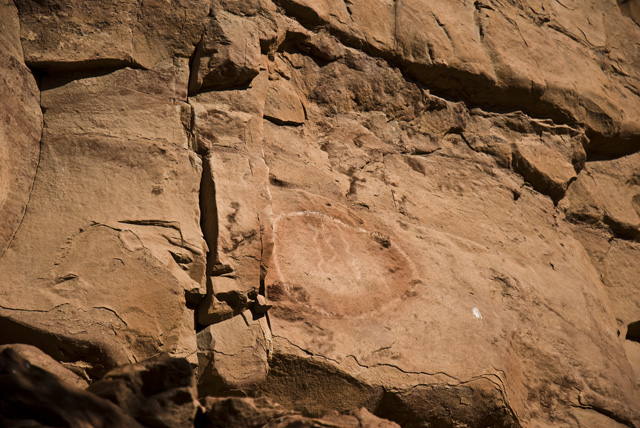
This circle with either three lightning bolts or symbols of rain falling in zig-zag patterns was nearby to the person and the sun/moon.
Then, what really got me excited was the snake petroglyph. There it was in all its huge, long glory. The wavy nature of the snake for me, indicates water rivulets. And of course, Bololokan, the rainbow snake of the Yavapai myths (they were later to come to the Verde Valley after the Sinagua came and then left). And so when the Grandmother called it a “colored snake” you could indeed see the colors on this petroglyph–white with red. It’s a beautiful symbol.
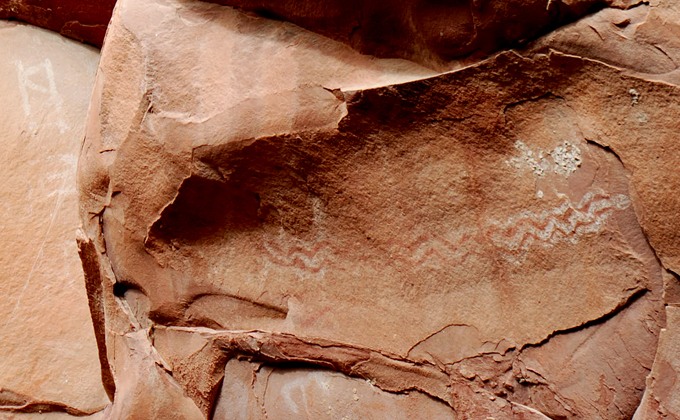
When I saw this water snake petroglyph, I gave a yip of delight. Why? Because in my prior non-ordinary reality talk with the Grandmother at the western end of this village, she had mentioned the “colored snake.” Now, here on the east end of the village, was proof of it. For me, it’s important to connect with the local guardians before doing any snooping around. That way, I can always double check what I get by proof that I will see later with my own two eyes.
We saw any number of people, children and ceremony. In some houses on the back wall would be all kinds of petroglyphs. And in other homes, there was nothing.
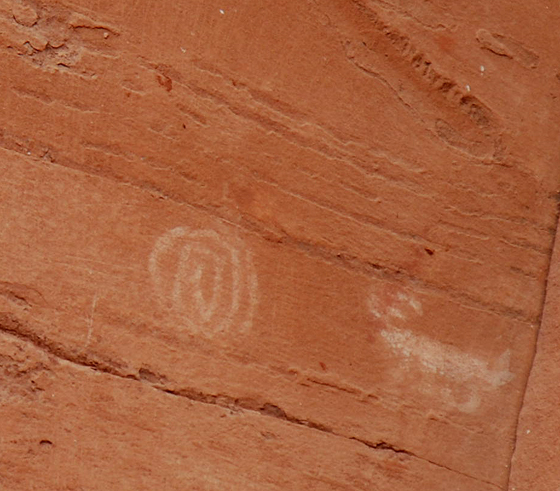
There were at least three spirals, and this was one of them. The other two were much larger and very faint. I was able to photograph them, but the white was so faded that only one of them could be seen.
What fascinated me was the last ruin. It was within a huge hallowed out cave. The top of the cave had been blackened by smoke. I told Marty that this was the ‘kitchen’ for all the homes that made up Honanki. There would be one central place where fire would be made. And none of the other ruins/homes had any blackening visible anywhere. So, this was the place where all the families got together to do their daily cooking. And who would want to build a fire within these small flagstone and mud homes? The people would be run out with the smoke! This central cooking place also had plenty of petroglyphs, but they were on the sides of it and nothing on the roof that was now blackened.
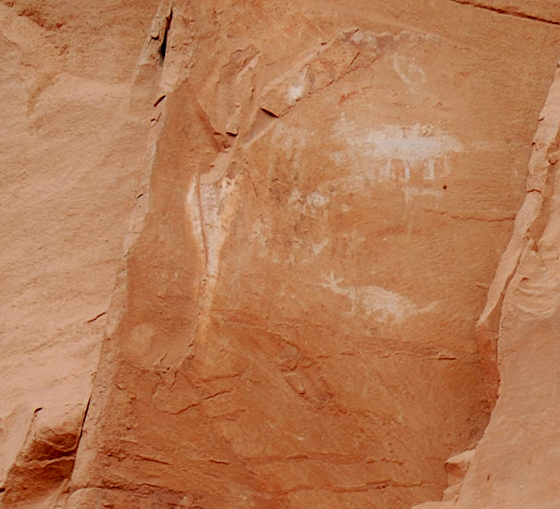
Here is one that looks like a coyote howling (below) and another animal above it. What is interesting is that most of the petroglyphs are at least 12 to 20 feet off the ground. I wonder if the artists used a ladder to get up that high? Or be suspended and dangling from ropes far above? One of the things that has protected the petroglyphs at Honanki is they are too high to reach to be defaced or destroyed.
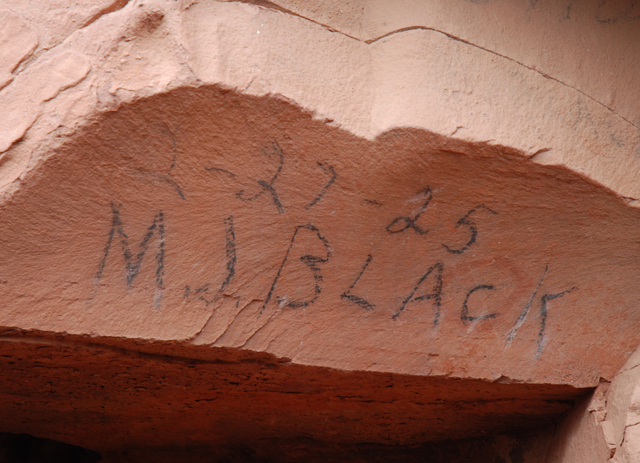
And speaking of graffiti and defacing these beautiful petroglyphs…an ML Black wrote his or her name across a circle petroglyph in 1925. You can see the circle where the “ac” of the name is at.
Here is a gorgeous centipede petroglyph. Unfortunately, a person named Thompson who visited in 1949 had to put his or her name right next to it.
This is the eastern side of the village. You can see how the Sinagua fashioned their mud the flagstone bricks to the shape of the butte that protected them from weather. The whole village is built on the south side in order to receive the warmth of the sunlight during the winter months.
I hope you enjoyed this. Tell us what you think these petroglyphs show or say? What do you see in them? Please give us your insights. More to come! Marty Reinstra will be giving her report on our adventures with the next blog. And, more photos of beautiful petroglyphs from Honanki!
In Spirit, Eileen
